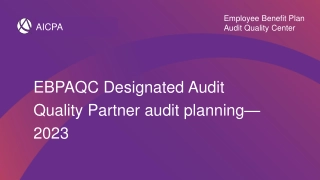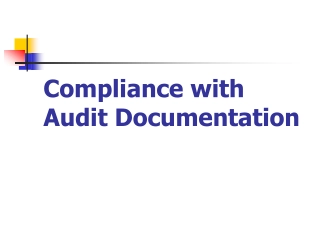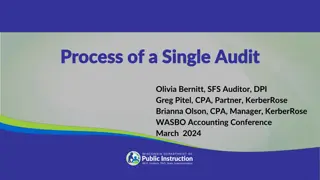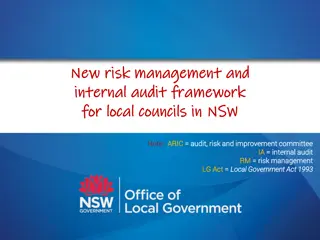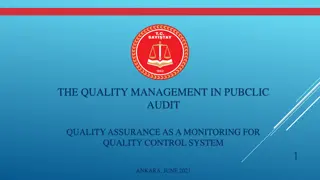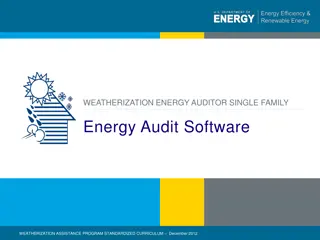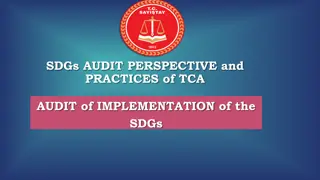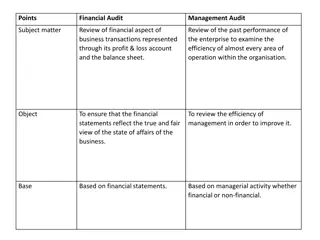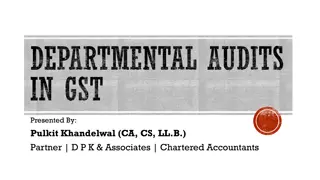
Managing External Audits, Inquiries, and Inspections
This document outlines procedures for handling external audits, inquiries, and inspections, providing detailed steps for responding to unexpected visits, FDA Form 483 issuance, and FDA warning letters. It emphasizes prompt communication, preparation, and collaboration with relevant offices to ensure proper responses to regulatory inspections and compliance requirements.
Download Presentation

Please find below an Image/Link to download the presentation.
The content on the website is provided AS IS for your information and personal use only. It may not be sold, licensed, or shared on other websites without obtaining consent from the author. If you encounter any issues during the download, it is possible that the publisher has removed the file from their server.
You are allowed to download the files provided on this website for personal or commercial use, subject to the condition that they are used lawfully. All files are the property of their respective owners.
The content on the website is provided AS IS for your information and personal use only. It may not be sold, licensed, or shared on other websites without obtaining consent from the author.
E N D
Presentation Transcript
EXTERNAL AUDITS, INQUIRIES, INSPECTIONS AND/OR UNANNOUNCED VISIT EXTERNAL AUDITS, INQUIRIES, INSPECTIONS AND/OR UNANNOUNCED VISITS S Unexpected Unexpected Audits, Inquiries, Inspections, or Unannounced Visits ( For Cause or Not for Cause ) Answer the phone or email. Notify the Executive Director of HRPO (Martha Jones) within 1 working day. working day. Contact OVCR HRQA group for audit prep guidance. When scheduling the close out conversation, contact HRPO and OVCR to have a representative from both offices attend the visit. If a 483 is issued by the FDA at close-out, OVCR, HRPO and OGC (Office of General Counsel) will aid in composing your response to the FDA. Submit follow-up information to the Executive Director of HRPO within 1 working day 1 working day of receipt. within 1 within
EXTERNAL AUDITS, INQUIRIES, INSPECTIONS AND/OR UNANNOUNCED VISIT EXTERNAL AUDITS, INQUIRIES, INSPECTIONS AND/OR UNANNOUNCED VISITS S Unexpected Unexpected Audits, Inquiries, Inspections, or Unannounced Visits ( For Cause or Not for Cause ) Schedule an appropriate room with supplies and a list of staff contact names and telephone/pager numbers. Pre-review all research records and make available to the auditor. During the visit assign 1 person to the auditor. Make all copies for the auditor and make an exact copy for your records. For any questions that you are asked, if you are unsure on how to respond, contact OVCR or HRPO for guidance. **You have the right to have a Washington University representative available to you throughout this process**
FDA WARNING LETTER FDA Form 483: FDA Form 483: The FDA Form 483 notifies the company s management / principal investigator of objectionable conditions observed during an inspection. At the conclusion of an inspection, the FDA Form 483 is presented and discussed with the company s senior management/ principal investigator. Companies/principal investigators are encouraged to respond to the FDA Form 483 in writing with their corrective action plan and then implement that corrective action plan expeditiously.
FDA WARNING LETTER Warning Letter: Warning Letter: A Warning Letter indicates that higher FDA officials have reviewed the observations and that a serious violation(s) may exist. This formal notification allows for voluntary and prompt correction action. A Warning Letter: Includes evidence collected to support observations and provides further explanation Establishes a background of warnings should further action be required by the FDA Might be hand-delivered or the agency may invite top corporate management to a meeting at the District Office or Center The site must reply, in writing, within a time line as prescribed (usually 15 days) or request an extension and provide justification for request
EXTERNAL AUDITS, INQUIRIES, INSPECTIONS AND/OR UNANNOUNCED VISIT EXTERNAL AUDITS, INQUIRIES, INSPECTIONS AND/OR UNANNOUNCED VISITS S Routine Routine Audits, Inquiries, or Inspections: Report findings to HRPO within 10 working days receipt if the findings meet HRPO s reporting requirements. Submit Reportable Event Form (REF) Reportable Event Form (REF) for non- compliance findings. If there are no findings, this information should be reported at Continuing Review Continuing Review. within 10 working days of **It s a good practice to document your response to findings.**
INTERNAL WASHINGTON UNIVERSITY AUDITS INTERNAL WASHINGTON UNIVERSITY AUDITS- -FULL REVIEW FULL REVIEW **Answer the phone or email **Answer the phone or email ** How to prepare: How to prepare: Have the following information (unaltered) ready and available for review: Consent/assent documents Participant research records all information regarding the participant s study participation. Electronic data/databases Specimen logs and storage Master/enrollment logs Regulatory files **
INTERNAL WASHINGTON UNIVERSITY AUDITS INTERNAL WASHINGTON UNIVERSITY AUDITS- -FULL REVIEW FULL REVIEW After review is After review is complete: You will receive a full report and will have a chance to respond to the findings Your response and the full report are then reviewed by our QA/QI Committee. A letter summarizing the Committee s response to the report is sent to the PI, HRPO, OVCR, and your Department/Division head. HRPO will then contact you regarding the findings and appropriate submission/reporting processes. complete:
INTERNAL WASHINGTON UNIVERSITY AUDITS INTERNAL WASHINGTON UNIVERSITY AUDITS- - CONSENT REVIEW CONSENT REVIEW **Answer the phone or email **Answer the phone or email ** How to prepare: Have all consent/assent documents, enrollment/master logs, and all notes to files related to the consent/assent process available for review. After review is complete: A formal report is prepared and reviewed by the Chair of the QA/QI Committee. A letter summarizing the Committee s response to the report is sent to the PI, HRPO, OVCR, and the Department/Division head. HRPO will then contact you regarding the findings and appropriate submission/reporting processes. ** How to prepare:
External Audits Internal Audits Best Practices Ensure Scientifically Valid Data Collection, and Protection of the Ensure Scientifically Valid Data Collection, and Protection of the Rights, Safety, and Welfare of the Human Research Participants Rights, Safety, and Welfare of the Human Research Participants
WHAT CAN YOU DO TO AVOID NON-COMPLIANCE????
WHAT CAN YOU DO TO AVOID NON WHAT CAN YOU DO TO AVOID NON- -COMPLIANCE? COMPLIANCE? Regardless of funding type, factoring in Good Clinical Practice Regardless of funding type, factoring in Good Clinical Practice (GCP) into your research practices is a vital first step. (GCP) into your research practices is a vital first step. Good Clinical Practice is an international ethical and scientific quality standard for designing, conducting, recording, and reporting trials that involve the participation of human subjects. Compliance with this standard provides public assurance that the rights, safety and well-being of trials subjects are protected, consistent with the ethical principles outlined in the Declaration of Helsinki and ensuring that the clinical trial data are credible.
Documentation should be Documentation should be ALCOA A Attributable ttributable ALCOA : L Legible egible C Contemporaneous ontemporaneous O Original riginal A Accurate ccurate
ATTRIBUTABLE It should be clear who has documented the data Sign & date source documents/case report forms Document what you do and what you don t do (and why)
LEGIBLE Readable Signatures are identifiable Ensure all scans/copies are good quality
CONTEMPORANEOUS The information should be documented in the correct time frame along with the flow of events. If a clinical observation cannot be entered when made, chronology should be recorded. Acceptable amount of delay should be defined and justified.
ORIGINAL Original, if not original should be exact copy record made by the appropriate person. The investigator should have the original source document. Follow OVCR s guidance on electronic storage of consent and research documents: https://research.wustl.edu/ComplianceAreas/clinical/ GuidelinesPolicies/Pages/Electronic-Storage- Research-Consent-Documents.aspx exact copy; the first
ACCURATE Accurate Consistent Real representation of facts facts
Ultimately the participants research record should outline his or her research journey as it happened and thus form the foundation for strong research. Data should always be backed up by evidence.
WHAT CAN YOU DO TO AVOID NON-COMPLIANCE? Always execute informed consent/assent to the fullest extent and in line with your approved protocol. Print consent and assent forms directly from myIRB. Treat all optional items left blank in the consent form as no. Never complete any part of the consent for the participant. Any changes to the consent (regardless of how minor) must be approved by HRPO first. Document the consent conversation, and always provide a copy of the fully executed consent to participants.
WHAT CAN YOU DO TO AVOID NON-COMPLIANCE? The research record should contain documentation of each participant s study involvement. The research record should contain documentation of each participant s study involvement. This would include, but is not limited to, participant enrollment status, dates of completed assessments, and complete or incomplete study interventions/ questionnaires and/or assessments. With hardcopy study documentation, any item not completed should be lined through, initialed With hardcopy study documentation, any item not completed should be lined through, initialed and dated. and dated. It is not a good practice to document information on post-it notes. Consider creating a source document to capture study information. It is also a good practice to document why a record is incomplete or an assessment could not be obtained. Attaching Attaching a note to file or documenting in a running note missing items, dates, incomplete a note to file or documenting in a running note missing items, dates, incomplete questions, missing assessments, etc., is another way to document why a record is incomplete, questions, missing assessments, etc., is another way to document why a record is incomplete, but the note to file entry must also be signed and dated. but the note to file entry must also be signed and dated.
WHAT CAN YOU DO TO AVOID NON-COMPLIANCE? With electronic study documentation, consider creating a data field to capture any With electronic study documentation, consider creating a data field to capture any general notes about why study interventions were not completed or were partially general notes about why study interventions were not completed or were partially complete complete Study interventions as outlined in the myIRB application (including any attached Study interventions as outlined in the myIRB application (including any attached protocols) should be followed without deviation. protocols) should be followed without deviation. Any modifications or deviations from the protocol (no matter how minor) should be approved by HRPO prior to implementation. It is also important that the attached protocol is consistent with the myIRB application. All questionnaires, scales, and/or interviews executed by participants must be approved All questionnaires, scales, and/or interviews executed by participants must be approved by HRPO prior to implementation. by HRPO prior to implementation.
WHAT CAN YOU DO TO AVOID NON-COMPLIANCE? Hardcopy source documents/data collections forms should contain at the very least Hardcopy source documents/data collections forms should contain at the very least participant ID and study visit date on each loose page. participant ID and study visit date on each loose page. It is suggested that this be documented on each loose page in case the files are ever separated. Research team members should document each task they perform. Research team members should document each task they perform. This can be done by creating designated data fields or sections on the data collection forms for PI/Designee signature and date (or initials and date). It is also important that the designated signature sections are completed to the fullest extent.

